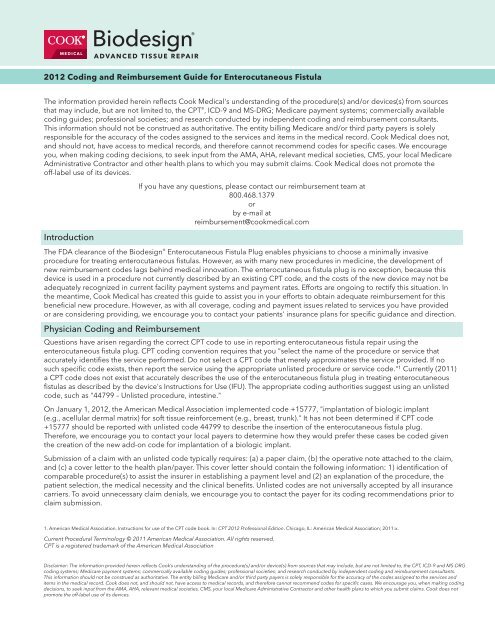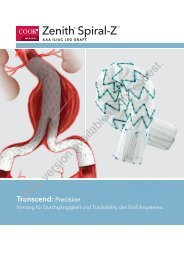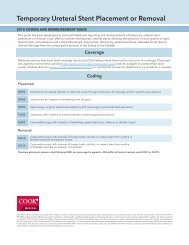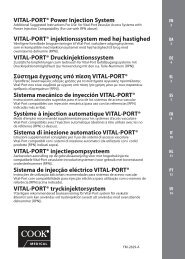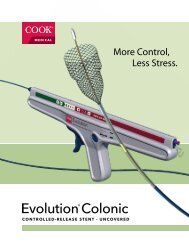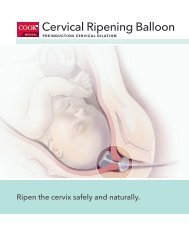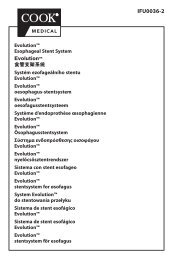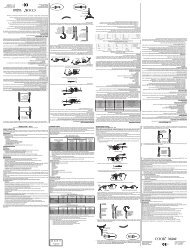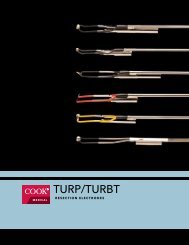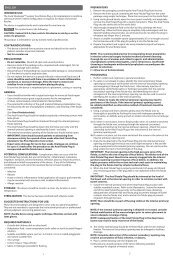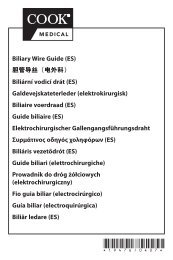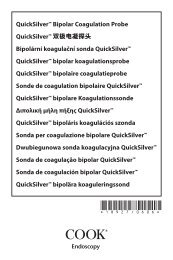Biodesign Enterocutaneous Fistula Plug 2012 - Cook Medical
Biodesign Enterocutaneous Fistula Plug 2012 - Cook Medical
Biodesign Enterocutaneous Fistula Plug 2012 - Cook Medical
Create successful ePaper yourself
Turn your PDF publications into a flip-book with our unique Google optimized e-Paper software.
<strong>2012</strong> Coding and Reimbursement Guide for <strong>Enterocutaneous</strong> <strong>Fistula</strong><br />
The information provided herein reflects <strong>Cook</strong> <strong>Medical</strong>'s understanding of the procedure(s) and/or devices(s) from sources<br />
that may include, but are not limited to, the CPT ® , ICD-9 and MS-DRG; Medicare payment systems; commercially available<br />
coding guides; professional societies; and research conducted by independent coding and reimbursement consultants.<br />
This information should not be construed as authoritative. The entity billing Medicare and/or third party payers is solely<br />
responsible for the accuracy of the codes assigned to the services and items in the medical record. <strong>Cook</strong> <strong>Medical</strong> does not,<br />
and should not, have access to medical records, and therefore cannot recommend codes for specific cases. We encourage<br />
you, when making coding decisions, to seek input from the AMA, AHA, relevant medical societies, CMS, your local Medicare<br />
Administrative Contractor and other health plans to which you may submit claims. <strong>Cook</strong> <strong>Medical</strong> does not promote the<br />
off-label use of its devices.<br />
Introduction<br />
<strong>Biodesign</strong> ®<br />
A D VA N C E D T I S S U E R E PA I R<br />
If you have any questions, please contact our reimbursement team at<br />
800.468.1379<br />
or<br />
by e-mail at<br />
reimbursement@cookmedical.com<br />
The FDA clearance of the <strong>Biodesign</strong> ® <strong>Enterocutaneous</strong> <strong>Fistula</strong> <strong>Plug</strong> enables physicians to choose a minimally invasive<br />
procedure for treating enterocutaneous fistulas. However, as with many new procedures in medicine, the development of<br />
new reimbursement codes lags behind medical innovation. The enterocutaneous fistula plug is no exception, because this<br />
device is used in a procedure not currently described by an existing CPT code, and the costs of the new device may not be<br />
adequately recognized in current facility payment systems and payment rates. Efforts are ongoing to rectify this situation. In<br />
the meantime, <strong>Cook</strong> <strong>Medical</strong> has created this guide to assist you in your efforts to obtain adequate reimbursement for this<br />
beneficial new procedure. However, as with all coverage, coding and payment issues related to services you have provided<br />
or are considering providing, we encourage you to contact your patients' insurance plans for specific guidance and direction.<br />
Physician Coding and Reimbursement<br />
Questions have arisen regarding the correct CPT code to use in reporting enterocutaneous fistula repair using the<br />
enterocutaneous fistula plug. CPT coding convention requires that you "select the name of the procedure or service that<br />
accurately identifies the service performed. Do not select a CPT code that merely approximates the service provided. If no<br />
such specific code exists, then report the service using the appropriate unlisted procedure or service code." 1 Currently (2011)<br />
a CPT code does not exist that accurately describes the use of the enterocutaneous fistula plug in treating enterocutaneous<br />
fistulas as described by the device's Instructions for Use (IFU). The appropriate coding authorities suggest using an unlisted<br />
code, such as "44799 – Unlisted procedure, intestine."<br />
On January 1, <strong>2012</strong>, the American <strong>Medical</strong> Association implemented code +15777, "implantation of biologic implant<br />
(e.g., acellular dermal matrix) for soft tissue reinforcement (e.g., breast, trunk)." It has not been determined if CPT code<br />
+15777 should be reported with unlisted code 44799 to describe the insertion of the enterocutaneous fistula plug.<br />
Therefore, we encourage you to contact your local payers to determine how they would prefer these cases be coded given<br />
the creation of the new add-on code for implantation of a biologic implant.<br />
Submission of a claim with an unlisted code typically requires: (a) a paper claim, (b) the operative note attached to the claim,<br />
and (c) a cover letter to the health plan/payer. This cover letter should contain the following information: 1) identification of<br />
comparable procedure(s) to assist the insurer in establishing a payment level and (2) an explanation of the procedure, the<br />
patient selection, the medical necessity and the clinical benefits. Unlisted codes are not universally accepted by all insurance<br />
carriers. To avoid unnecessary claim denials, we encourage you to contact the payer for its coding recommendations prior to<br />
claim submission.<br />
1. American <strong>Medical</strong> Association. Instructions for use of the CPT code book. In: CPT <strong>2012</strong> Professional Edition. Chicago, IL: American <strong>Medical</strong> Association; 2011:x.<br />
Current Procedural Terminology © 2011 American <strong>Medical</strong> Association. All rights reserved.<br />
CPT is a registered trademark of the American <strong>Medical</strong> Association<br />
Disclaimer: The information provided herein reflects <strong>Cook</strong>’s understanding of the procedure(s) and/or device(s) from sources that may include, but are not limited to, the CPT, ICD-9 and MS-DRG<br />
coding systems; Medicare payment systems; commercially available coding guides; professional societies; and research conducted by independent coding and reimbursement consultants.<br />
This information should not be construed as authoritative. The entity billing Medicare and/or third party payers is solely responsible for the accuracy of the codes assigned to the services and<br />
items in the medical record. <strong>Cook</strong> does not, and should not, have access to medical records, and therefore cannot recommend codes for specific cases. We encourage you, when making coding<br />
decisions, to seek input from the AMA, AHA, relevant medical societies, CMS, your local Medicare Administrative Contractor and other health plans to which you submit claims. <strong>Cook</strong> does not<br />
promote the off-label use of its devices.
Contesting Noncoverage<br />
If the procedure is still denied by Medicare or another payer after following this process, you may need to further educate<br />
the payer regarding medical necessity, FDA clearance and/or the efficacy of the procedure. If reimbursement is denied, the<br />
reason should be listed under the explanation of benefits (EOB), and we encourage the operating physician to contact the<br />
local health plan's medical directors to discuss the clinical merits of this procedure.<br />
Influencing Payer Decision Making<br />
If Medicare is a dominant payer and you plan to do the procedure on a regular basis, you may want to go directly to the<br />
Carrier Advisory Committee (CAC) member or Carrier <strong>Medical</strong> Director (CMD) for your state Medicare carrier. The medical<br />
director contact directory may be accessed through the following link: www.cms.hhs.gov/apps/contacts<br />
Private payer coverage determinations are usually made by the payer's technology or medical device group. As with<br />
Medicare, we encourage you to contact your other local commercial health plans to discuss coverage of this procedure,<br />
whether for a specific case or for overall approval of the <strong>Biodesign</strong> <strong>Enterocutaneous</strong> <strong>Fistula</strong> <strong>Plug</strong>.<br />
Facility Coding and Reimbursement<br />
The use of the enterocutaneous fistula plug to treat enterocutaneous fistulas is a minimally invasive procedure. It is anticipated<br />
that the procedure will be performed in both the inpatient and outpatient settings.<br />
The method and amount of facility reimbursement for medical services is dependent on a number of factors, including:<br />
a) the site of service (ambulatory surgery center vs. hospital outpatient dept. vs. hospital inpatient), and b) the payer<br />
(Medicare, commercial insurance plans, Medicaid, etc.). Following is a brief discussion of the current (<strong>2012</strong>) facility<br />
reimbursement environment for the enterocutaneous fistula plug.<br />
Hospital Outpatient Department<br />
Medicare<br />
Medicare pays hospital outpatient facilities under the Outpatient Prospective Payment System (OPPS). Medicare updates its<br />
list of approved procedures annually. Each of these procedures is assigned to an Ambulatory Payment Classification (APC)<br />
created by Medicare. Although there are several hundred APCs, a CPT code is assigned to only one APC. The facility is<br />
reimbursed the APC amount that the CPT code is assigned to.<br />
CPT code 44799, "Unlisted procedure, intestine," is currently assigned to APC 0153 "Peritoneal and Abdominal Procedures,"<br />
and the current national average Medicare fee schedule amount for this APC is $1,917.51. 2 The actual fee schedule amount<br />
varies from hospital to hospital, based on local wage indices, geographic location, etc.<br />
On January 1, <strong>2012</strong>, the American <strong>Medical</strong> Association implemented code +15777, "implantation of biologic implant (e.g.,<br />
acellular dermal matrix) for soft tissue reinforcement (e.g., breast, trunk)." It has not been determined if CPT code +15777<br />
should be reported with unlisted code 44799 to describe the insertion of the enterocutaneous fistula plug. Therefore, we<br />
encourage you to contact your local payer to determine how they would prefer these cases be coded given the creation of<br />
the new add-on code for implantation of a biologic implant.<br />
Medicare also requires that pass-through or C-code devices used in the hospital outpatient setting be included on the claim.<br />
The American Hospital Association's central office on HCPCS suggests using C1763, "Connective tissue, non-human," to<br />
describe the <strong>Biodesign</strong> <strong>Enterocutaneous</strong> <strong>Fistula</strong> <strong>Plug</strong>. C1894, "Introducer/Sheath," should also be reported to describe the<br />
Flexor ® sheath.<br />
Please note the importance of submitting appropriate charges for this procedure, as Medicare uses charge data to ensure<br />
equitable payment in the future. According to CMS:<br />
"Our goal is to establish payment rates that provide appropriate relative payment for all services paid under the OPPS without creating<br />
payment disincentives that may reduce access to care. As a matter of policy, we do not tell hospitals how to set their charges for their services.<br />
However, we will continue to inform hospitals of the importance of their charge data in future rate setting and encourage them to include all<br />
appropriate charges on their Medicare claims." 3<br />
Also note that revenue codes are to be assigned at the provider's discretion.<br />
2 Medicare Program; Hospital Outpatient Prospective Payment System and CY <strong>2012</strong> Payment Rates, Vol. 76, No. 76, December 28, 2011.<br />
3 Medicare Program; Changes to the OPPS and Calendar Year 2006 Payment Rates; Final Rule, Fed Regist. Vol. 70, No. 223, November 21, 2005.<br />
Disclaimer: The information provided herein reflects <strong>Cook</strong>’s understanding of the procedure(s) and/or device(s) from sources that may include, but are not limited to, the CPT, ICD-9 and MS-DRG<br />
coding systems; Medicare payment systems; commercially available coding guides; professional societies; and research conducted by independent coding and reimbursement consultants.<br />
This information should not be construed as authoritative. The entity billing Medicare and/or third party payers is solely responsible for the accuracy of the codes assigned to the services and<br />
items in the medical record. <strong>Cook</strong> does not, and should not, have access to medical records, and therefore cannot recommend codes for specific cases. We encourage you, when making coding<br />
decisions, to seek input from the AMA, AHA, relevant medical societies, CMS, your local Medicare Administrative Contractor and other health plans to which you submit claims. <strong>Cook</strong> does not<br />
promote the off-label use of its devices..
Commercial Insurance<br />
Unlike Medicare, commercial insurers have not established a consistent national payment methodology, so arrangements<br />
between insurers and hospitals vary considerably. Because of this, it is not possible for <strong>Cook</strong> <strong>Medical</strong> to offer guidance<br />
to hospitals regarding any individual plan. We encourage you to work closely with your local hospital management and<br />
insurance plans to understand their contracted payment arrangements. A coordinated effort between the physician and<br />
hospital can be effective in obtaining appropriate reimbursement for innovative procedures, such as the treatment of<br />
enterocutaneous fistulas using the <strong>Biodesign</strong> <strong>Enterocutaneous</strong> <strong>Fistula</strong> <strong>Plug</strong>.<br />
When submitting claims, it may be helpful to provide the following documents:<br />
• The patient's medical record documenting the need for this procedure<br />
• The operative note describing the procedure<br />
• An invoice documenting the cost of the enterocutaneous fistula plug<br />
Ambulatory Surgery Center (ASC)<br />
Medicare<br />
Medicare's payment system for ASCs is also based on a list of approved procedures identified by CPT codes, but it is not the<br />
same list that is used for hospital outpatient facilities. Unlisted codes do not appear on the ASC-approved list. We encourage<br />
you to contact your local Medicare carrier to discuss how it wants these claims submitted.<br />
When submitting claims, it may be helpful to provide the following documents:<br />
• The patient's medical record documenting the need for this procedure<br />
• The operative note describing the procedure<br />
• An invoice documenting the cost of the enterocutaneous fistula plug<br />
Commercial Insurance<br />
Unlike Medicare, commercial insurers have not established a consistent national payment methodology, so arrangements<br />
between insurers and hospitals vary considerably. Because of this, it is not possible for <strong>Cook</strong> <strong>Medical</strong> to offer guidance to<br />
ASCs regarding any individual plan. We encourage you to work closely with your local ASC management and insurance plans<br />
to understand their contracted payment arrangements. A coordinated effort between the physician and ambulatory surgery<br />
center can be effective in obtaining appropriate reimbursement for innovative procedures such as enterocutaneous fistula<br />
repair using the enterocutaneous fistula plug.<br />
When submitting claims, it may be helpful to provide the following documents:<br />
• The patient's medical record documenting the need for this procedure<br />
• The operative note describing the procedure<br />
• An invoice documenting the cost of the enterocutaneous fistula plug<br />
Hospital Inpatient<br />
Medicare<br />
Medicare pays for inpatient hospital services based on the MS-DRG (Medicare Severity Diagnosis-Related Group) system.<br />
Within this system, Medicare assigns patients to a DRG based primarily on their diagnoses (coded with ICD-9 diagnosis<br />
codes) and any procedures (coded with ICD-9 procedure codes) performed during their hospital stay. Medicare has<br />
established hospital-specific DRG fee schedules, which determine how much the hospital will get paid for a given admission.<br />
These amounts vary from hospital to hospital based on the hospital's location, whether it's a teaching hospital, and whether it<br />
sees a disproportionate share of low-income patients.<br />
ICD-9 diagnosis codes for enterocutaneous fistulas include:<br />
Facilities coding for repair of a gastrocutaneous<br />
fistula should consider:<br />
Facilities coding for repair of a small-intestinal<br />
fistula should consider:<br />
Facilities coding for repair of a large-intestinal<br />
fistula should consider:<br />
569.81 <strong>Fistula</strong> of intestine, excluding rectum and anus<br />
998.6 Persistent postoperative fistula<br />
44.63 Closure of other gastric fistula<br />
46.74 Closure of fistula of small intestine, except duodenum<br />
46.76 Closure of fistula of large intestine<br />
Disclaimer: The information provided herein reflects <strong>Cook</strong>’s understanding of the procedure(s) and/or device(s) from sources that may include, but are not limited to, the CPT, ICD-9 and MS-DRG<br />
coding systems; Medicare payment systems; commercially available coding guides; professional societies; and research conducted by independent coding and reimbursement consultants.<br />
This information should not be construed as authoritative. The entity billing Medicare and/or third party payers is solely responsible for the accuracy of the codes assigned to the services and<br />
items in the medical record. <strong>Cook</strong> does not, and should not, have access to medical records, and therefore cannot recommend codes for specific cases. We encourage you, when making coding<br />
decisions, to seek input from the AMA, AHA, relevant medical societies, CMS, your local Medicare Administrative Contractor and other health plans to which you submit claims. <strong>Cook</strong> does not<br />
promote the off-label use of its devices.
Submitting a claim with diagnosis code 569.81 and procedure code 44.63 as the primary procedure will typically group into<br />
one of the following DRGs:<br />
MS-DRG <strong>2012</strong> MS-DRG Description Relative Weight 4<br />
DRG 326<br />
DRG 327<br />
DRG 328<br />
Stomach, Esophageal and Duodenal Procedures with Major Complications<br />
and Comorbidities<br />
Stomach, Esophageal and Duodenal Procedures with Complications and Comorbidities<br />
Stomach, Esophageal and Duodenal Procedures without Complications and<br />
Comorbidities or Major Complications and Comorbidities<br />
5.6803<br />
Disclaimer: The information provided herein reflects <strong>Cook</strong>’s understanding of the procedure(s) and/or device(s) from sources that may include, but are not limited to, the CPT, ICD-9 and MS-DRG<br />
coding systems; Medicare payment systems; commercially available coding guides; professional societies; and research conducted by independent coding and reimbursement consultants.<br />
This information should not be construed as authoritative. The entity billing Medicare and/or third party payers is solely responsible for the accuracy of the codes assigned to the services and<br />
items in the medical record. <strong>Cook</strong> does not, and should not, have access to medical records, and therefore cannot recommend codes for specific cases. We encourage you, when making coding<br />
decisions, to seek input from the AMA, AHA, relevant medical societies, CMS, your local Medicare Administrative Contractor and other health plans to which you submit claims. <strong>Cook</strong> does not<br />
promote the off-label use of its devices..<br />
2.747<br />
1.3848<br />
Submitting a claim with diagnosis code 569.81 and procedure code 46.74 or 46.76 as the primary procedure will typically<br />
group into one of the following DRGs:<br />
DRG 329 Major Small and Large Bowel Procedures with Major Complications and Comorbidities 5.3215<br />
DRG 330 Major Small and Large Bowel Procedures with Complications and Comorbidities 2.5911<br />
DRG 331<br />
Major Small and Large Bowel Procedures without Complications and Comorbidities or<br />
Major Complications and Comorbidities<br />
1.6254<br />
Submitting a claim with diagnosis code 998.6 and procedure code 44.63, 46.74 or 46.76 as the primary procedure will<br />
typically group into one of the following DRGs:<br />
DRG 907 Other O.R. Procedures for Injuries with Major Complications and Comorbidities 3.9661<br />
DRG 908 Other O.R. Procedures for Injuries with Complications and Comorbidities 1.9298<br />
DRG 909<br />
Other O.R. Procedures for Injuries without Complications and Comorbidities or Major<br />
Complications and Comorbidities<br />
1.1612<br />
Actual hospital payment rates will vary, based, among other things, on the hospital's geographic location, its status as a<br />
teaching hospital and whether it sees a disproportionate share of low-income patients.<br />
Note: As mentioned under the hospital outpatient section, charges play an important role in future CMS rate-setting;<br />
therefore, it is important to capture all appropriate service charges.<br />
Also note that revenue codes are to be assigned at the provider's discretion.<br />
Commercial Insurance<br />
Unlike Medicare, commercial insurers have not established a consistent national payment methodology, so arrangements<br />
between insurers and hospitals vary considerably. Because of this, it's not possible for <strong>Cook</strong> <strong>Medical</strong> to offer guidance<br />
to hospitals regarding any individual plan. We encourage you to work closely with your local hospital management and<br />
insurance plans to understand the contracted payment arrangements between them. A coordinated effort between the<br />
physician and hospital can be quite effective in obtaining appropriate reimbursement for innovative procedures such as<br />
enterocutaneous fistula closure using the <strong>Biodesign</strong> <strong>Enterocutaneous</strong> <strong>Fistula</strong> <strong>Plug</strong>.<br />
When submitting claims, it may be helpful to provide the following documents:<br />
• The patient's medical record documenting the need for this procedure<br />
• The operative note describing the procedure<br />
• An invoice documenting the cost of the enterocutaneous fistula plug<br />
4 Hart A, ed. Appendix D. In: DRG Expert: A Comprehensive Guidebook to the DRG Classification System. 28th ed. Eden Prairie, MN: OptumInsight; 2011.<br />
© COOK <strong>2012</strong> SUR-BE-EFPCRG-EN-<strong>2012</strong>03


